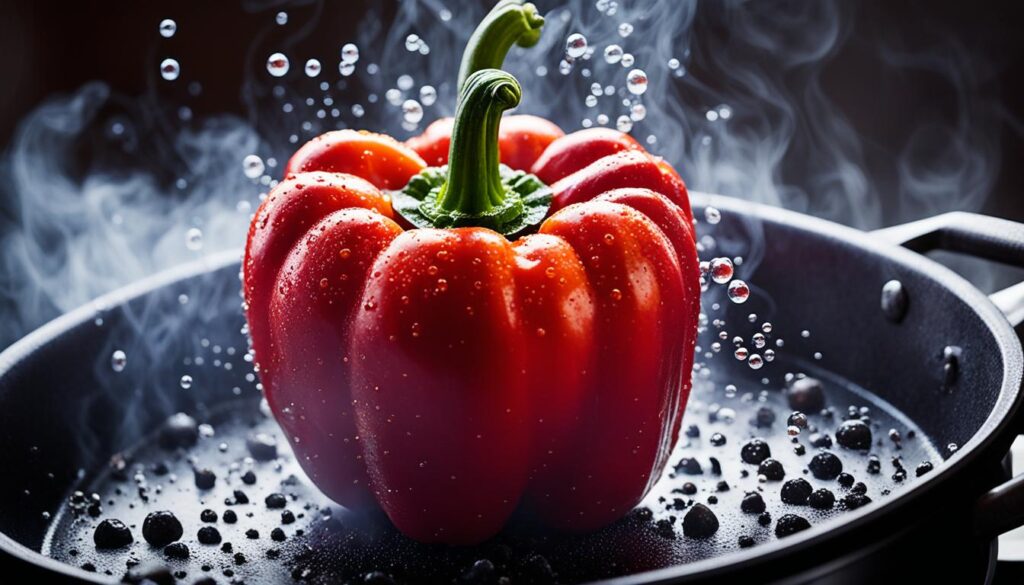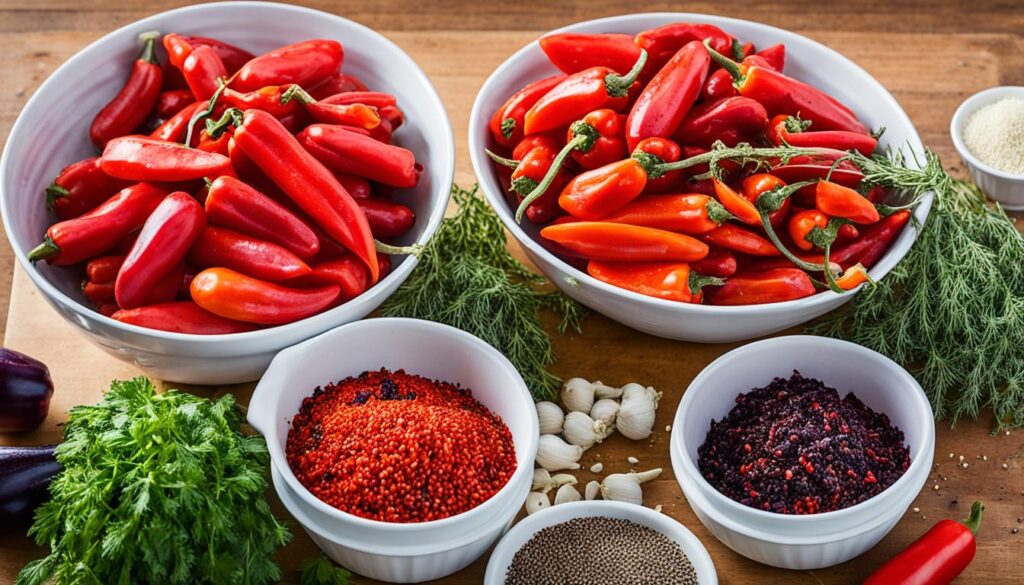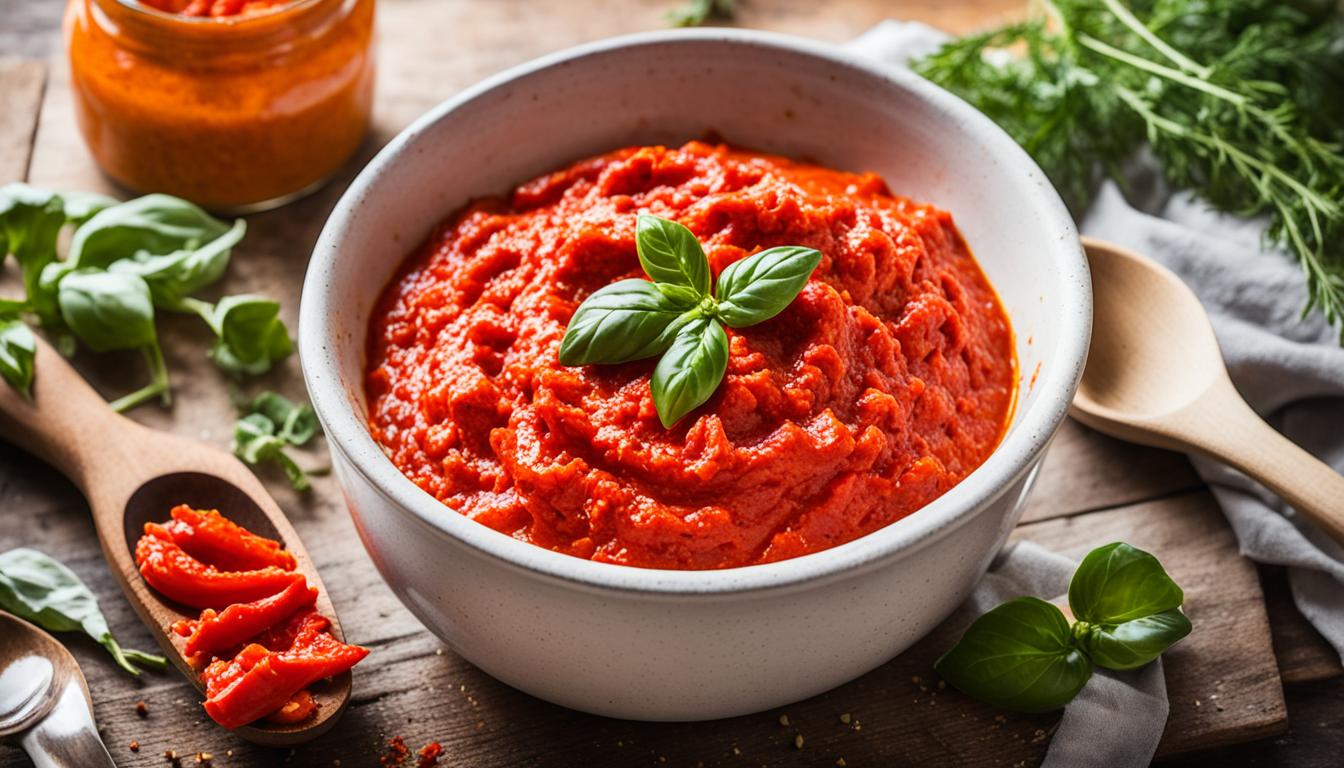Have you ever tasted the rich and smoky flavors of traditional Serbian cuisine? If not, you’re in for a treat! In this article, we’ll uncover the secrets of making authentic ajvar, a delicious roasted red pepper sauce that is a staple in Serbian households. Get ready to tantalize your taste buds and experience the true essence of Serbian gastronomy.
Key Takeaways:
- Learn how to make homemade ajvar using a traditional Serbian recipe.
- Discover the different preparation methods for ajvar, including grilling and simmering.
- Understand the importance of roasting the red peppers and eggplant to enhance the flavor of ajvar.
- Explore the effects of simmering on the taste and character of the sauce.
- Get insights into the key ingredients and measurements needed to create the perfect ajvar.
Exploring Different Preparation Methods for Ajvar
When it comes to making ajvar, there are different preparation methods that can result in unique flavors and textures. Adjusting the cooking techniques can elevate the sauce from ordinary to extraordinary. In this section, we’ll dive into two key considerations when preparing ajvar: grilling and simmering.
The Grilling Method
Grilling the red peppers and eggplant over a charcoal fire is a popular method for making ajvar. This technique imparts a delightful smoky flavor that adds depth to the sauce. To achieve this, start by charring the peppers and eggplant until the skins are blackened. This can be done on a grill or in the oven. Once charred, remove the skin, seeds, and cores from the peppers, and peel the skin off the eggplant. Then, finely chop or puree the flesh and combine it with the other ingredients. This grilling method is perfect for those who enjoy a smoky, robust flavor in their ajvar sauce.
The Simmering Process
Simmering the ajvar sauce after combining the ingredients is another technique to consider. This step involves gently cooking the sauce over low heat for a period of time, allowing the flavors to meld together. Simmering can result in a sweeter flavor profile and a more intense red pepper taste. During the simmering process, the sauce thickens, which can make it easier to spread or use as a dip. For those who prefer a richer and more pronounced flavor, simmering is an essential step in making ajvar.
Ultimately, the choice of preparation method is a matter of personal preference. Some may prefer the smoky nuances achieved through grilling, while others may enjoy the sweeter flavors that simmering brings out. You can even experiment and combine both methods to find your perfect balance. Now that we’ve explored the different techniques, it’s time to move on and understand the importance of roasting the red peppers and eggplant, which we’ll cover in the next section.
The Importance of Roasting the Red Peppers and Eggplant
One of the key steps in making ajvar is roasting the red peppers and eggplant. This process involves charring the peppers over a hot grill or in the oven until they are blackened. The skin is then removed, and the flesh is finely chopped or pureed. Roasting the peppers and eggplant imparts a smoky flavor to the sauce and enhances the overall taste of ajvar.
Roasting Method: Grill vs Oven
When it comes to roasting the red peppers and eggplant for ajvar, there are two main methods: grilling and using the oven. Grilling the peppers and eggplant over direct heat creates a beautiful char and adds a distinct smokiness to the sauce. On the other hand, roasting them in the oven provides a convenient option especially during colder months or if you don’t have access to a grill.
“Roasting the red peppers and eggplant over a hot grill or in the oven is crucial for achieving the authentic smoky flavor of ajvar.”
Regardless of the method you choose, make sure the peppers and eggplant are thoroughly blackened on the outside. This not only softens the flesh but also gives the sauce its characteristic smokiness. The roasted peppers and eggplant should be tender enough to easily remove the skin and seeds, allowing for a smooth and velvety texture in the final ajvar.
“A well-roasted red pepper and eggplant is the foundation of a rich and flavorful ajvar sauce.”
Finely Chopped or Pureed?
Once the roasted peppers and eggplant are cooled and peeled, the next step is to prepare them for the sauce. Some prefer to finely chop the flesh, resulting in a chunkier ajvar with visible pieces of peppers and eggplant. Others opt for a smoother consistency by pureeing the ingredients together. The choice between finely chopped or pureed ajvar depends on personal preference and desired texture.
Finely chopped ajvar showcases the individual elements of the sauce, allowing for a more rustic presentation and a satisfying bite. On the other hand, pureed ajvar creates a creamier texture, perfect for spreading on bread, crackers, or using as a dip.
“The texture of ajvar, whether finely chopped or pureed, can elevate the overall dining experience and complement various dishes.”
Summary: The Roasting Process
The importance of roasting the red peppers and eggplant cannot be overstated when it comes to making ajvar. It is during this step that the deep, smoky flavors are infused into the sauce, creating a unique and enticing taste profile. Whether you choose to grill or roast in the oven, ensuring that the peppers and eggplant are thoroughly blackened is key. Additionally, the decision to finely chop or puree the roasted ingredients gives you control over the texture and overall presentation of the ajvar.
The Simmering Process and its Effects on Flavor
Simmering the ajvar sauce is a crucial step that can significantly impact its flavor profile. Traditionally, after combining all the ingredients, the sauce is gently simmered on the stovetop. This simmering process serves two important purposes – it helps to thicken the sauce and enhances the flavors.
During the simmering process, the ingredients meld together, creating a harmonious blend of flavors. The prolonged cooking time allows the flavors of the roasted red peppers, eggplant, garlic, oil, vinegar, and seasonings to intensify and develop their full potential.
“Simmering the ajvar sauce gradually builds depth and complexity, resulting in a richer and more aromatic final product.”
– Traditional Ajvar Recipe
While simmering, the sauce undergoes a gentle transformation. The heat causes the natural sugars in the red peppers and eggplant to release, resulting in a subtly sweeter character. This simmering process also helps to highlight the bright, intense flavors of the red peppers, contributing to the distinctive taste of ajvar.
However, it’s important to note that not all recipes call for simmering. Some variations of ajvar skip this step, favoring a quicker and simpler preparation method. This choice ultimately comes down to personal preference – whether you desire a more nuanced, complex flavor or prefer a fresher, lighter sauce.
Ajvar Dip Recipe
If you’re planning to use ajvar as a dip, simmering the sauce is highly recommended. The simmering process helps to achieve a smooth and velvety consistency, perfect for dipping your favorite snacks. Here’s a simple recipe for ajvar dip:
- 1 cup roasted red bell peppers, peeled and deseeded
- 1 cup roasted eggplant, peeled
- 2 garlic cloves
- 2 tablespoons olive oil
- 1 tablespoon white vinegar
- Salt and pepper to taste
Note: You can adjust the quantities according to your preference and taste.
In a blender or food processor, combine the roasted red peppers, roasted eggplant, garlic cloves, olive oil, white vinegar, salt, and pepper. Blend until smooth and creamy. Transfer the mixture to a saucepan and simmer over low heat for 10 minutes, stirring occasionally. Allow the ajvar dip to cool before serving.
Enjoy the rich flavors of this ajvar dip as a perfect companion for your favorite chips, crackers, or fresh vegetables!

| Simmering Process | Effects on Flavor |
|---|---|
| Thickens the sauce | Creates a smoother and more velvety texture |
| Enhances flavors | Develops a richer and more aromatic taste |
| Results in a sweeter character | Highlights the intense flavors of the red peppers |
Simmering the ajvar sauce brings out the best in its ingredients, elevating the overall flavor and texture. Whether you choose to simmer or not, the decision ultimately lies in your personal preference. Experiment with different variations to find the perfect balance of flavors for your ajvar creation.
Ingredients and Measurements for Ajvar
When it comes to making ajvar, using the right ingredients and measurements is essential in achieving the authentic and traditional flavors of this popular Serbian red pepper sauce. Here are the key ingredients you’ll need:
- Red bell peppers
- Eggplant
- Garlic
- Oil (sunflower or olive)
- Vinegar (white)
- Salt
- Black pepper
The ratio of red peppers to eggplant can vary depending on your personal preference. Some recipes suggest equal parts, while others may use more peppers for a stronger flavor. Feel free to experiment and find the ratio that suits your taste.
In addition to the main ingredients, you may consider adding some optional ingredients to customize your ajvar:
- Roasted chili peppers for a spicy kick
- A small amount of sugar to balance the flavors
Remember to season your ajvar with salt and black pepper to taste. Adjust the measurements according to your personal preference, keeping in mind the desired level of spiciness, sweetness, and overall flavor profile.
To help you get a better understanding of the ingredients and measurements, here’s a visual representation:

| Ingredients | Measurements |
|---|---|
| Red bell peppers | – |
| Eggplant | – |
| Garlic | – |
| Oil (sunflower or olive) | – |
| Vinegar (white) | – |
| Salt | – |
| Black pepper | – |
Remember, the measurements will depend on the quantity of ajvar you want to make and your personal taste preferences. Use the table above as a guide and adjust accordingly.
Step-by-Step Instructions for Making Ajvar
To make ajvar, follow these simple step-by-step instructions:
- Roast the red peppers and eggplant: Start by roasting the red peppers and eggplant until they are blackened. This can be done over a grill or in the oven. The charred skin will impart a smoky flavor to the sauce.
- Cool and remove the skin: Once the peppers and eggplant are roasted, allow them to cool. Then, remove the skin, seeds, and cores from the peppers. Peel the skin off the eggplant and discard it.
- Pulse in a food processor: In a food processor or blender, combine the roasted peppers, eggplant, garlic, oil, vinegar, salt, and pepper. Pulse the mixture until it is finely chopped or pureed. This will create a smooth and flavorful consistency.
- Transfer to a saucepan and simmer: Transfer the ajvar sauce to a saucepan and simmer it over medium-low heat for 30 minutes. Stir occasionally to prevent sticking or burning.
- Taste and adjust the seasoning: After simmering, taste the ajvar sauce and adjust the seasoning if needed. Add more salt, pepper, or vinegar to suit your personal preference.
- Cool and serve: Let the ajvar sauce cool to room temperature before serving or storing it. The flavors will develop further as it sits, so it’s even better the next day!
Ajvar is a versatile sauce that can be used in a variety of dishes. Whether as a dip, a spread, or a sauce, it adds a rich and smoky flavor to any meal. Try making ajvar at home using these step-by-step instructions, and explore the delicious world of Serbian cuisine!
Conclusion
Ajvar, the authentic Serbian roasted red pepper sauce, is a versatile and delicious addition to any dish. Whether you enjoy it as a dip, spread, or sauce, ajvar brings a unique and flavorful element to your meals. By following our step-by-step instructions and using traditional ingredients, you can easily create your own homemade ajvar recipe that captures the true essence of Serbian cuisine.
The choice of preparation method, such as grilling the peppers and eggplant or simmering the sauce, allows you to personalize the smoky and sweet flavors of ajvar to your liking. By roasting the red peppers and eggplant, you infuse the sauce with a delightful smoky taste. Simmering the sauce adds depth and intensifies the red pepper flavor, resulting in a sweeter character.
Embrace the rich flavors of the Balkans by making authentic ajvar in your own kitchen. From its vibrant red color to its robust taste, this homemade ajvar recipe will transport you to the heart of Serbia. Whether you’re serving it alongside grilled meats, spreading it on crusty bread, or using it as a sauce for your favorite dishes, ajvar is sure to impress. Discover the beauty of homemade ajvar and elevate your culinary adventures with this beloved Serbian condiment.
